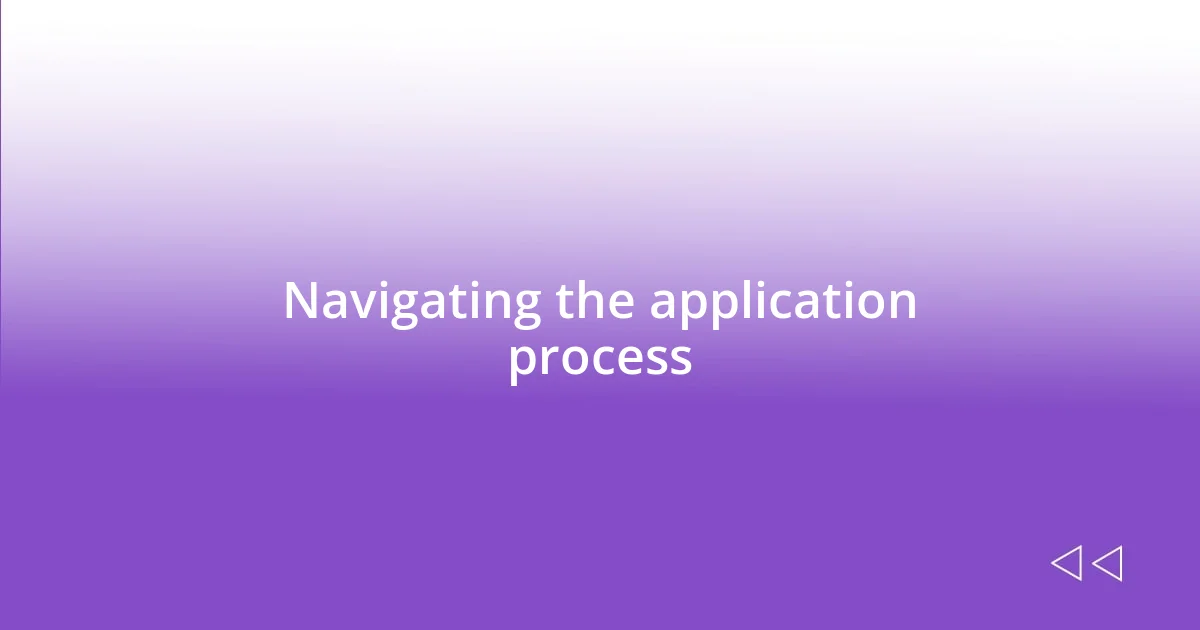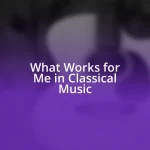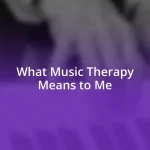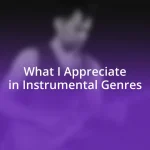Key takeaways:
- Understanding different types of music licenses—like synchronization and mechanical licenses—empowers artists to protect their rights and monetize their work effectively.
- Clear communication and negotiation are vital in licensing agreements to ensure that artists retain their rights while fostering valuable relationships.
- Future trends point towards digital integration and flexible licensing models, enabling artists to maintain control over their work while adapting to new market dynamics.

Understanding music licensing basics
Diving into the world of music licensing can feel overwhelming at first, much like navigating a maze where every turn uncovers new rules and requirements. I vividly remember the first time I encountered the concept of royalties; I was puzzled by how many different types there were, like performance royalties and mechanical royalties. It’s crucial to grasp these basics because understanding them will save you from potential pitfalls down the road.
One of the most eye-opening moments for me was learning about the difference between synchronization rights and master rights. This distinction carved a path into the business side of music that I was completely unaware of. Have you ever wondered why some songs resonate so well in films and commercials? It all comes down to these licenses ensuring that creators are compensated fairly for their work.
As I navigated through my licensing journey, I found it incredibly helpful to think of contracts as conversations rather than one-sided agreements. Many musicians overlook the importance of negotiating terms, often signing away rights without realizing the long-term impact. I urge you to consider what it truly means to protect your artistic integrity while also reaping the rewards of your hard work.

Types of music licensing agreements
When I first delved into the world of music licensing, I was astounded to discover the variety of agreements available. Each type serves a unique purpose, and understanding these distinctions is essential for anyone involved in the music industry. Here are some of the main types of music licensing agreements:
-
Synchronization License: This allows the licensee to use the music in audiovisual works like films, TV shows, or online videos. The first time I saw my song paired with visuals, the rush of excitement was indescribable.
-
Master License: This grants permission to use a specific sound recording, different from the composition itself. When I made my first master licensing deal, it felt like a milestone that validated my work.
-
Mechanical License: This is required for the reproduction of music in physical formats, such as CDs or vinyl. I remember the thrill of seeing my music pressed onto a vinyl record for the first time—an unforgettable moment in my career.
-
Public Performance License: This permits the performance of music in public spaces, such as live venues or streaming services. I learned the hard way about the importance of securing this license when a venue played my track without permission!
-
Print License: This allows the reproduction of music notation, such as sheet music. I never thought about this until a local band wanted to cover one of my songs for a charity event—lost royalties could have been significant without this license.
Understanding these agreements has not only empowered me to make informed decisions but has also deepened my appreciation for the music business. Each type of license represents a vital step in ensuring that artists are justly recognized for their talents.

My journey with licensing music
My passion for music licensing truly evolved as I began to interact with various rights holders. One of my first experiences involved negotiating directly with a small production company that wanted to use my track for a short film. I felt a rush of anxiety, but also a surge of empowerment, as I realized that these discussions could shape my career. It was like stepping into a new world where my voice mattered in determining the value of my art.
Reflecting on my licensing journey, I recall my first few licensing agreements. Those moments felt surreal, as I signed contracts and suddenly saw my music being used in promotional materials. The realization that my work reached new audiences made my heart swell with pride. However, it was also a sobering reminder of the responsibility that came with those agreements. Ensuring my rights were protected became a priority I learned that the fine print often held implications I hadn’t considered.
Throughout this journey, my perspective on music licensing transformed from mere compliance to an essential part of my artistic expression. There were instances where I had to walk away from potential deals because the terms didn’t align with my values. Each decision taught me the importance of standing firm for my vision. I learned that navigating music licensing is not just about the money; it’s about preserving the integrity of my art while embracing exciting opportunities.
| Type of License | Purpose |
|---|---|
| Synchronization License | Use in audiovisual works like films or TV shows. |
| Master License | Permission for using a specific sound recording. |
| Mechanical License | Required for physical reproductions like CDs or vinyl. |
| Public Performance License | Allows performances in public spaces and live venues. |
| Print License | Reproduces music notation, such as sheet music. |

Navigating the application process
Navigating the application process for music licensing can feel overwhelming, especially if it’s your first time. I remember sitting at my desk, staring at the forms, feeling a mix of excitement and trepidation. The key is to break it down into manageable steps. Start by thoroughly researching the specific requirements for the type of license you need. It’s amazing how the more you clarify your goals, the more confidence you gain in filling out those forms.
I’ll never forget the moment I submitted my first application. I was anxious, pacing back and forth, wondering if I had included everything required. Each checkbox seemed monumental; little did I know that checking those boxes signaled my commitment to my work. I learned to double-check everything—documents, contact info, and the correct fees. A small oversight could delay your application, and no one wants that frustration.
As you navigate the process, don’t hesitate to reach out for help. When I hit a wall with technical details, I found support from peers and online forums invaluable. There’s a real community out there, filled with people who’ve walked the same path. Have you ever felt stuck and then found unexpected guidance? That’s the beauty of this journey—suddenly, you’re not alone.

Tips for successful licensing
When it comes to successful music licensing, I’ve learned the importance of establishing clear communication with rights holders from the very beginning. I remember my early negotiations where misunderstandings could have easily derailed a deal. Asking questions about everything, from the intended use of my music to the timeline of the project, helped me avoid pitfalls. Have you thought about how much clarity can enhance your confidence during negotiations? It certainly made a difference for me.
Protecting your rights should be at the forefront of every licensing agreement. I once had a deal that seemed perfect, but after digging deeper, I found that the terms were rather vague. That experience taught me that it’s vital to read every word of the contract, even the fine print. Don’t be afraid to consult a legal expert when something feels off; it might save you from potential heartache down the road.
Another key tip is to maintain flexibility during negotiations. I recall a situation where I had to adjust my rates to accommodate a smaller indie project I believed in. By compromising, I forged a meaningful relationship with the team, which led to more opportunities later. How often do we think about long-term relationships in the music industry? Sometimes, a little give-and-take can open doors you never knew existed.

Common challenges in music licensing
One of the most significant challenges I faced in music licensing was understanding the different types of licenses and when to use each. I remember feeling lost amidst terms like synchronization licenses and mechanical licenses, trying to figure out what precisely suited my needs. It’s a bit like choosing the right tool for a job—without clarity, your efforts can go awry. Have you ever had that moment where you realize you’ve been using the wrong instrument all along?
Another hurdle is the financial aspect. I recall nervously considering how much to charge for licensing my music. Setting prices can feel like a tightrope walk—too high, and you might scare away potential clients; too low, and you undervalue your work. This balancing act can be daunting, especially when you’re passionate about your craft. Have you struggled with valuing your art in the past? That internal battle often tests our self-worth and confidence.
Finally, the ongoing negotiation process brings its own set of frustrations. I once found myself going back and forth with a production team for weeks, fine-tuning terms and conditions that felt like they would never reach resolution. Each email sparked a mix of hope and anxiety, hoping each round of feedback would move us closer to agreement. Does that sound familiar? It’s crucial to find patience and keep communication open during these times, reminding ourselves that the end goal is a partnership that benefits everyone involved.

Future trends in music licensing
The future of music licensing is undeniably heading towards greater digital integration. I’ve noticed a growing trend in using automated platforms that simplify the licensing process for both artists and clients. Platforms that leverage AI can streamline negotiations and even help determine appropriate pricing based on market trends. It makes me wonder, will we eventually see a world where most licensing happens in a fully digitized, almost hands-free manner?
As technology evolves, I’ve also observed a shift towards more flexible licensing agreements. Artists want to retain their rights while still getting their music in front of audiences. For instance, I’ve experimented with “pay-per-play” models, where musicians receive compensation each time their work is used. This approach not only protects our rights but also creates a more sustainable income stream. Have you thought about how these new models might change your relationship with your art?
Additionally, I believe we will see an increase in collaborations between artists and brands that go beyond traditional licensing. My experience has shown me that partnerships can be incredibly rewarding, providing exposure and financial benefits. For instance, working with a local coffee shop to use my music in their advertisement led to a spike in my social media following. This raises an interesting question: how can artists creatively align with brands to forge mutually beneficial partnerships in the age of digital media?














